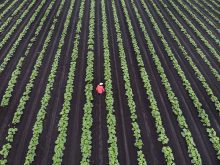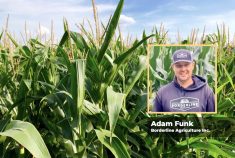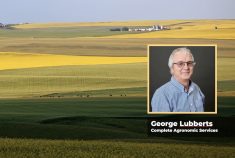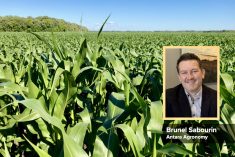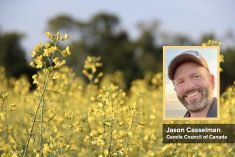It was Shawn Senko, CCC agronomy specialist for northwest Saskatchewan, who said on our June 9 Canola Watch conference call, “Canola crops are knee-high, but that’s only because we’re down on our knees praying for rain.”
Agronomists at the time talked of thin canola. Crops looked so pathetic, Canola Watch ran an article June 10 called “Top 10 reasons for patchy emergence.” Dry topsoil was top of the list.
Lack of moisture hammered production estimates, with an outlook of 13 million to 14 million tonnes based on yields of 30 bu./ac. considered optimistic. Even as rains returned in July, forecasts remained fairly low. Statistics Canada’s Aug. 21 report, based on late-July grower surveys, had total canola production at 13.3 million tonnes. Alberta’s average yield outlook was 29.4 bu./ac., down 21.6 per cent from 2014. Saskatchewan’s was 28.4 bu./ac., down 12.1 per cent. (Manitoba, where conditions had been better, was looking at a yield increase over 2014.)
But by harvest, the situation for many growers had completely reversed. StatsCan shocked the industry in December with its estimate at 17.2 million tonnes, Canada’s second-biggest crop on record. Final yield estimates were 36.5 bu./ac. for Saskatchewan, 39.7 for Alberta and 40.3 for Manitoba.
“Many growers in my area of central Alberta ended up with record yields,” reports Keith Gabert, CCC agronomy specialist for central Alberta south. Growers, he says, were shocked, asking themselves, “How did I end up with 65 bu./ac. in a year when I would have been happy with 38?”

Six key factors contributed
1. Rain. This is the obvious one. Weather maps show precipitation across huge parts of Alberta, Saskatchewan and northwest Manitoba at less than 40 per cent of average for May and June. Add in the areas at 40 to 60 per cent of average, and most of the canola growing region is accounted for. Farms were lucky if they had more than an inch of rain in June. Then July brought relief for many regions. (Not all, unfortunately, but enough to change the tune for Canada’s canola crop.)
2. The nature of canola. Canola is relatively efficient at recycling and reusing nutrients from older parts of the plant that may have dried up prematurely. Canola pods also contain chloroplasts and have capacity for photosynthesis, which can contribute to yield when other parts of the plant have been stressed earlier in the year.
Read Also

Could crop sharing be a viable option for your farm?
Crop sharing could be a good option for young and beginning farmers.
And most importantly, canola is a semi-determinate plant type, which means it can continue to branch out even when parts of the plant are already filling seeds or are nearing maturity. Canola fits into the middle ground between indeterminate plants that continue to grow vegetatively even while they produce seed, and determinate plants which have a period of vegetative growth that abruptly switches to reproductive growth. Canola is not an indeterminate perennial, but it can keep producing new growing points throughout the season. Plants that survived the drought could respond to improved conditions by growing more branches and thus more flowers, pods and seed.
While wheat is determinate, it too has a fair bit of plasticity in tiller numbers, seeds per spike and kernel weight, says Pierre Hucl, a breeder at the University of Saskatchewan. But wheat is not as well suited to a full recovery.
“If you have a June and July with 10 per cent to 20 per cent of normal precipitation as we did in 2015 around Saskatoon, crops start running out of time to recover. In the case of a cereal plant, that late rain typically means a new flush of tillers and a crop with two stages of maturity and all the quality issues that might arise,” Hucl says. “It basically restarts from scratch.” Whereas canola keeps on branching and flowering.
Sally Vail, research scientist in oilseed breeding at AAFC in Saskatoon, says, “If there is a combination of resources — water, nutrients and heat — available for growth and the canola plants have not reached their reproductive capacity, canola plants keep on growing and flowering.”
Vail adds that co-operative fall weather is important to bring these late branches to maturity. “We were lucky across the Prairies this fall as conditions allowed for continuation of seed filling. An untimely frost could have literally frozen this process.”
3. A long fall. Many areas did not get a killing frost in September, potentially adding several million tonnes to Canada’s canola production number for 2015. That long fall was essential to allow late secondary and tertiary branches as well as the many reseeded crops to reach maturity.
4. Improved genetics. Modern, more vigorous canola hybrids are better able to hang on and then respond when conditions improve, says Murray Hartman, oilseed extension specialist with Alberta Agriculture and Forestry. “Genetic improvements have probably allowed for better growth in poor conditions,” he says. “Hybrids are better able to tolerate stress, and to recover and compensate.”
5. Low levels of disease. Dry conditions in the first half of the season meant blackleg, clubroot and sclerotinia stem rot levels were generally very low in Alberta and Saskatchewan. In Saskatchewan, for example, sclerotinia stem rot cost growers about eight bu./ac. in lost yield in 2014, but only three bu./ac. in 2015. The CCC recommended this year not to spray for sclerotinia in Saskatchewan and Alberta, and most growers didn’t spray — which further improved the profit situation.
6. Good agronomy. Through CCC agronomy specialists and other sources, growers were reminded that stands of only two plants per square foot can usually outprofit a reseeded crop. While a million or more acres were reseeded — with good results in many cases — crops not reseeded often recovered fairly well once the weather turned positive.
Advice on making sure to protect thin crops from flea beetles and weed competition, and how to manage uneven crops all season long, helped protect the plants that were there. And finally, encouraging growers to hold off on swathing until at least 50 to 60 per cent seed colour change on the main stem meant more seeds in the side branches matured and contributed to yield.

Next year may be different
As part of the agronomy message, growers are reminded this winter that planning for 2016 based on what worked in 2015 is probably not a good idea.
Best practices did not necessarily produce the best results in 2015. “Thin crops with room to branch out took advantage of late moisture and maybe even deep nitrogen to fill in, finish flowering and maximize seed size,” Gabert says, and these low-population stands produced the above-average yields that surprised growers.
Normally a thin stand or late-seeded crop would not outyield a well-established early stand. As Hartman says, “Forget about what worked well this year because the other nine years in 10, something’s going to happen to make these thin and later-seeded crops yield less.”
Gabert cuts the odds even further. “I’d hope the experience in 2015 is more like a one-year-in-20 scenario.”
Jay Whetter is communications manager and Canola Watch editor with the Canola Council of Canada. For a link to a video with Murray Hartman explaining why 2015 experiences should not change best practices, search for the article “What saved 2015?” at canolawatch.org.



